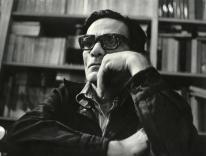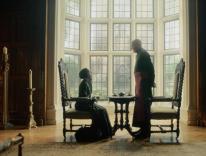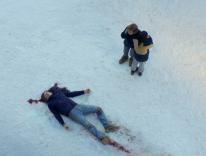David Mitchell’s virtuosic novel Cloud Atlas enfolds six plots into one theme: No man is an island but neither is any era. In all times, in all places, as one of the book’s less savory characters would have it, “the weak are meat the strong do eat”; and, as the more sympathetic characters learn, the weak must rebel, occasionally aided by those who are both strong and compassionate. There is a kind of crypto-Buddhist strain running through the book, suggesting that the souls of predators, victims, rescuers, and self-rescuers reappear in different bodies throughout history.
Six stories, six genres. In the tradition of nineteenth-century travel narratives (e.g., Melville’s Typee), a naïve young American lawyer of the 1840s recounts a voyage home from the South Seas during which he is murderously preyed upon by a con man but rescued by an island native he befriended before the voyage. Next, an epistolary narrative tells how a young British musician of the 1930s helped an elderly composer recover his creative powers. But the young man is then destroyed by the old man’s predations and his own riven nature. In a tale emulating pulp fiction, a California journalist of the 1970s, who has uncovered a corporate plot to make billions at the expense of innocent lives, must escape the hit men dispatched to kill her. In a darker version of a P. G. Wodehouse farce, a vanity-press publisher, hunted by the thuggish kin of one of his authors, takes refuge in what he takes to be a hotel; it turns out to be a nursing home run by a matron who could give Nurse Ratchet a lesson or two about institutional authoritarianism. The last two stories are science fiction: a “fabricant,” or clone, in a dystopian “Neo-Seoul” rebels against her masters; and a shepherd in a post-apocalypse wilderness rescues, and is rescued by, a kindly female visitor from a distant civilization.
The Russian doll structure of the book works amazingly well. Each of the first five stories freezes at a cliffhanger moment. The sixth story, the shepherd’s tale, is told complete. The author then backtracks, finishing the remaining five with a protagonist realizing that our lives are not our own, that our fates interlock with the fates of others, past and future. The book is a stunt, but a deeply humanistic one.
The film adaptation by the Wachowski siblings, Andy and Lana (makers of the pseudo-profound Matrix trilogy), and the German Tom Tykwer (maker of the truly clever Run, Lola, Run), is both faithful and unfaithful: faithful to the book’s events, despite a few tweaks, but unfaithful to its narrative technique and subtleties of characterization. It will mystify viewers who haven’t read the book and frustrate those who have. I don’t doubt the filmmakers love their source—they’ve crammed as much of it as will fit into the 165-minute running time—but they’ve failed to carry over into film what made the novel worthwhile: its magical command of sheer storytelling.
This failure is structural. Mitchell could afford to jump from story to story because he spent at least forty pages securing the reader’s interest in each narrative before leaping ahead to the next. By the time the reader arrives at the middle of the book, he or she is invested in six sets of characters and tantalized by all the cliffhangers. By contrast, the filmmakers don’t spend enough time cultivating the moviegoer’s interest in any of the stories; they hop immediately and continually from one tale to another, never sticking with any narrative for more than five minutes. We may not get bored, but we’re never gripped. As soon as our interest in one group of characters flickers into life we are whisked off to another era. It’s like watching two hours and forty-five minutes of previews.
And the contrasting genre styles demanded by the different stories are all undermined by the back-and-forth hurry of the screenplay. The suspense of the investigative reporter’s adventures can’t be maintained if it’s interrupted by the farce of the publisher’s antics, and the farce can’t evoke much laughter when it’s chopped up and scattered among the explosions and chases of the science-fiction and pulp-thriller episodes. Worst of all, the musician’s episode, the least genre-bound and most emotional of the stories, becomes a sketchy soap opera instead of the complex tragedy of self-destruction Mitchell created.
It’s not as if the moviemakers lack a cinematic precedent for what they’re trying to do. In 1916, D. W. Griffith released Intolerance, which also weaves together multiple stories, each of which explores the one theme stated by the film’s title. But Griffith proceeded like Mitchell, not the Wachowskis, by immersing the audience in one tale before going on to the next so that at the end he could achieve, as James Agee wrote, “the intercutting…between the climaxes of four parallel stories, like the swinging together of tremendous gongs.” That sort of intercutting doesn’t work when the parallel stories have been chopped into narrative confetti right from beginning to end.
The lead actors have been cast in multiple roles. Sometimes this supports the theme of reincarnation; sometimes it’s just showing off. It makes sense for Tom Hanks and Halle Berry to bond as journalist and helpful scientist in the espionage episode, and to bond again as mutually helpful visitor and shepherd in the futuristic yarn. But why does Hanks also play a clever but slimy con man, as well as an unclever, brutal thug? To show us he can do different accents? These and other odd casting choices throughout the movie demonstrate that the writer-directors, though wowed by the scope and implicit mysticism of the novel, had no real grasp of its essential seriousness and deeply felt compassion.
If the movie adaptation of a novel doesn’t convey the flavor of the book, it at least needs its own weight and coherence. This adaptation has neither. If I hadn’t read the book, I would never have guessed that these narratives contained such memorable characters and plangent emotions. Dave Eggers was right when he called the book “one of those how-the-holy-hell-did-he-do-it modern classics.” The question the movie leaves us asking is: Why the holy hell did they do it?
Please email comments to [email protected] and join the conversation on our Facebook page.
Share
Previous Story
Train of the Unknowns
Next Story
Two Poems


